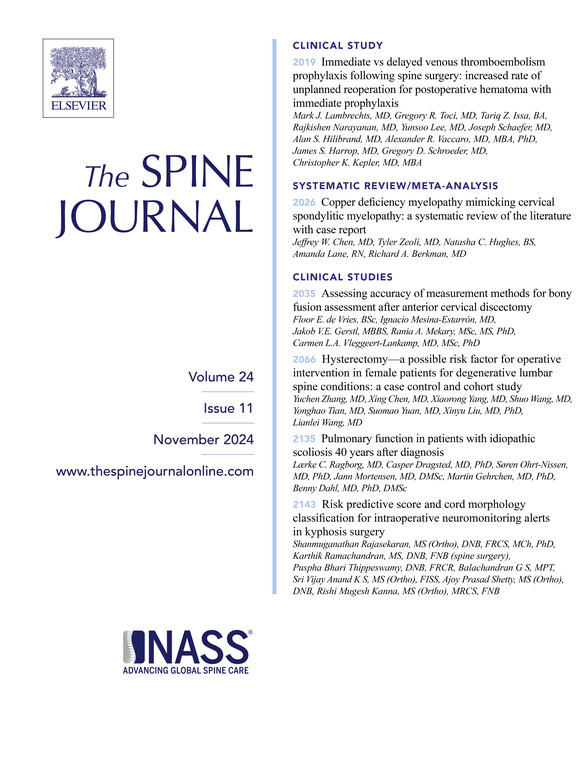颈椎面关节退变、面关节角度和脊柱旁肌肉退变与 C4/5 颈椎退行性骨质疏松症相关:倾向评分匹配研究。
IF 4.9
1区 医学
Q1 CLINICAL NEUROLOGY
引用次数: 0
摘要
背景情况:先前的研究假设,退行性颈椎滑脱症(DCS)可能受到椎间盘、面关节或颈椎排列导致的稳定性丧失的影响。同时,人们普遍认为面关节和脊柱旁肌肉参与了维持颈椎稳定性的工作。然而,脊柱旁肌肉形态和详细的面关节特征对 DCS 的影响还需要进一步研究。目的:比较 DCS 患者和无 DCS 患者的面关节特征、椎间盘退变和肌肉形态:研究设计/设置:回顾性队列研究:患者样本:2016年6月至2023年8月连续接受手术的退行性颈椎病患者:根据平移距离在X光片上评估DCS。通过计算机断层扫描(CT)测量颈椎面关节退变(CFD)、轴面上的面关节角度(FA-A)和矢状面上的面关节角度(FA-S)以及面关节张力(FT)。脊柱旁肌肉变性通过磁共振成像(MRI)进行评估,包括调整横截面积(aCSA)、功能性 aCSA 和脂肪浸润率(FI%)。此外,还对颈椎间盘的 Pfirrmann 分级进行了评估:方法:比较了匹配队列和非匹配队列的人口统计学和临床数据。对患有和未患有 DCS 的患者的椎间盘退变、肌肉退变和面关节特征(包括 FA、FT 和 CFD)进行了比较。此外,还比较了两组患者相邻节段的CFD程度。此外,还进行了逻辑回归以确定 DCS 的独立风险因素。最后,计算了接受者操作特征曲线(ROC)、曲线下面积(AUC)和风险因素的临界值:共对 431 名手术患者的年龄、性别和体重指数进行了倾向评分匹配,最终分析纳入了 146 名患者,其中 DCS 组 73 名,非 DCS 组 73 名。DCS患者在C4/5(脊柱滑脱节段)表现出更严重的CFD。此外,DCS 通常与更严重的 CFD、更水平的 FA-S、更多的 FT 和更差的脊柱旁肌肉健康有关,但椎间盘退变情况相似。此外,前方椎体滑脱与更严重的CFD以及屈肌和伸肌功能性aCSA下降有关。最后,更严重的CFD、更水平的FA-S和更高的深部伸肌FI%被认为是DCS的风险因素,临界值分别为1.5、44.5̊和37.1%:本研究表明,CFD、FA和FT以及腓肠肌旁变性与DCS相关。结论:该研究表明,CFD、FA 和 FT 以及副膈肌退变与 DCS 相关,可为 DCS 的发病机制和性质历史提供新的见解,并提示颈椎退变的演变过程。本文章由计算机程序翻译,如有差异,请以英文原文为准。
Cervical facet joint degeneration, facet joint angle, and paraspinal muscle degeneration are correlated with degenerative cervical spondylolisthesis at C4/5: a propensity score-matched study
BACKGROUND CONTEXT
Prior studies have hypothesized that degenerative cervical spondylolisthesis (DCS) may be influenced by loss of stability due to disc, facet joint or cervical alignment. Meanwhile, it is commonly believed that the facet joints and paraspinal muscles participate in maintaining cervical spine stability. However, the impact of paraspinal muscle morphology and detailed facet joint features on DCS requires further investigation.
PURPOSE
To compare facet joint characteristics, disc degeneration and muscle morphology between patients with DCS and those without DCS.
STUDY DESIGN/SETTING
Retrospective cohort study.
PATIENT SAMPLE
Consecutive surgical patients with degenerative cervical spondylosis from June 2016 to August 2023 were recruited.
OUTCOME MEASURES
DCS was assessed on X-ray based on the translation distance. Cervical facet joint degeneration (CFD), the facet joint angle on the axial plane (FA-A) and the facet joint angle on the sagittal plane (FA-S), and facet joint tropism (FT) were measured on computerized tomography (CT). Paraspinal muscle degeneration was assessed on magnetic resonance imaging (MRI) including by the adjusted cross-sectional area (aCSA), the functional aCSA, the fat infiltration ratio (FI%). The Pfirrmann grade of the cervical disc was also evaluated.
METHODS
Demographic and clinical data were compared in matched and unmatched cohorts. Disc degeneration, muscle degeneration and facet joint characteristics, including FA, FT and CFD, were compared between patients with and without DCS. Furthermore, the degree of CFD was compared with that of adjacent segments in both groups. Additionally, logistic regression was performed to determine independent risk factors for DCS. Finally, the receiver operating characteristic (ROC) curve, area under the curve (AUC) and cutoff value for the risk factors were calculated.
RESULTS
A total of 431 surgical patients were propensity score matched for age, sex and BMI, and 146 patients were included in the final analysis, with 73 patients in the DCS group and 73 patients in the non-DCS group. DCS patients exhibited more severe CFD at C4/5 (segment with spondylolisthesis). Additionally, DCS was generally associated with more severe CFD, a more horizontal FA-S, more FT and worse paraspinal muscle health but similar disc degeneration. In addition, anterior spondylolisthesis was related to more severe CFD and decreased functional aCSA of the flexors and extensors. Finally, more severe CFD, a more horizontal FA-S and a higher FI% on deep extensor were revealed to be risk factors for DCS, with cutoff values of 1.5, 44.5̊, and 37.1%, respectively.
CONCLUSIONS
This study demonstrated that CFD, the FA and FT and parasipnal muscle degeneration were associated with DCS. And may provide novel insight into the pathogenesis and nature history of DCS and suggest the evolution of degeneration in the cervical spine.
求助全文
通过发布文献求助,成功后即可免费获取论文全文。
去求助
来源期刊

Spine Journal
医学-临床神经学
CiteScore
8.20
自引率
6.70%
发文量
680
审稿时长
13.1 weeks
期刊介绍:
The Spine Journal, the official journal of the North American Spine Society, is an international and multidisciplinary journal that publishes original, peer-reviewed articles on research and treatment related to the spine and spine care, including basic science and clinical investigations. It is a condition of publication that manuscripts submitted to The Spine Journal have not been published, and will not be simultaneously submitted or published elsewhere. The Spine Journal also publishes major reviews of specific topics by acknowledged authorities, technical notes, teaching editorials, and other special features, Letters to the Editor-in-Chief are encouraged.
 求助内容:
求助内容: 应助结果提醒方式:
应助结果提醒方式:


